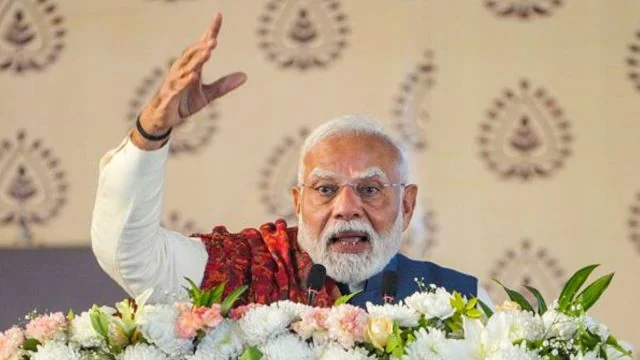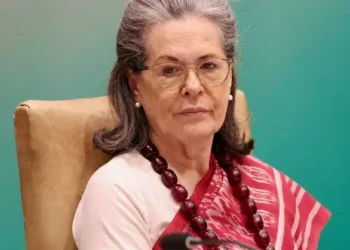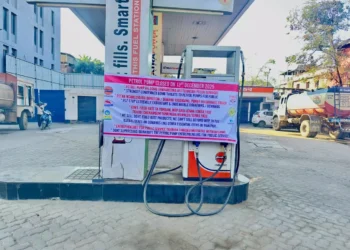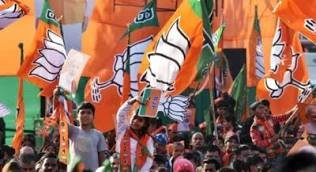At an event in Delhi’s Ashok Vihar, PM Modi took a swipe at Arvind Kejriwal over the alleged corruption-ridden renovation of his official residence, dubbed the “Sheesh Mahal.” The Prime Minister highlighted his government’s focus on affordable housing for the poor while unveiling new EWS flats and urban redevelopment projects.
BY PC Bureau
Prime Minister Narendra Modi’s high-profile intervention in the Delhi Assembly election campaign on Friday, November 2024, carried both political and symbolic weight. Addressing a public event in Delhi’s Ashok Vihar, the PM launched a pointed critique of AAP leader and former Chief Minister Arvind Kejriwal. The highlight of his address was an attack on the alleged opulence of Kejriwal’s official residence, nicknamed the “Sheesh Mahal,” juxtaposed against Modi’s emphasis on housing for the underprivileged.
Targeting AAP’s “Pro-Poor” Image
PM Modi’s strategy appeared to focus on undercutting Kejriwal’s carefully cultivated pro-poor image. By drawing attention to the controversial renovation of the AAP leader’s residence, the Prime Minister sought to frame the narrative of AAP’s hypocrisy in addressing the needs of Delhi’s marginalized citizens. Modi’s pointed remarks—“I could have also built a Sheesh Mahal, but for me, houses for the poor are more important”—not only highlighted alleged corruption but also resonated with themes of austerity and prioritization of public welfare.
This rhetorical move can be seen as part of a larger strategy to shift the narrative from governance successes touted by AAP to questions about its ethics and commitment to social equity.
Development Initiatives: A Counter-Narrative
The event also showcased PM Modi’s emphasis on tangible developmental achievements. Handing over keys to 1,675 newly built flats under the In-Situ Slum Rehabilitation Project in Ashok Vihar, Modi presented a direct counter-narrative to AAP’s claims of being the champion of Delhi’s poor. The flats, part of a broader vision to eliminate slums and improve urban living conditions, were symbolically named “Swabhiman Apartments”, reinforcing themes of dignity and empowerment.
Revisiting the Past:
The Prime Minister revisited his past during a visit to Ashok Vihar, where he handed over keys to newly constructed flats at Jailorwala Bagh, part of the ‘Swabhiman Apartments’ project. Reflecting on his time spent in Ashok Vihar during the Emergency in 1975, Modi noted how returning to the area stirred nostalgic memories.
Interacting with children and women in the courtyard of the multi-storey flats, the Prime Minister expressed optimism, stating, “I could see that their dreams were taller than the high-rise apartments.” In a heartfelt address, he referred to the flat beneficiaries as his extended family. Emphasizing his dedication to housing for all, he remarked, “I could have built a Sheesh Mahal for myself, but homes for my countrymen are more important.”
The symbolic gesture of handing over keys underscored the government’s commitment to improving lives. A beneficiary woman highlighted the transformational impact of the initiative, saying, “Modiji has not only given us a roof but also a new future for our children.” Residents expressed gratitude for the inclusion of modern facilities like lifts and playgrounds, showering the Prime Minister with flower petals.
Ahead of the event, PM Modi shared on social media, “Today is an important day for Delhi’s development,” emphasizing how the projects aim to enhance the ‘Ease of Living’ for citizens. He also spoke of inspiring growth through initiatives that prioritize education, innovation, and sustainable living.
Key Highlights of the Projects
The inauguration marked the completion of the second In-Situ Slum Rehabilitation Project by the Delhi Development Authority (DDA). The initiative aims to provide a healthier living environment for residents of JJ clusters. Flats costing the government Rs 25 lakh were offered to beneficiaries at a nominal contribution of Rs 1.42 lakh, with Rs 30,000 for five years of maintenance.
The event also included the launch of:
- Urban Redevelopment Projects:
- World Trade Centre (WTC), Nauroji Nagar: Replacing over 600 dilapidated quarters, the state-of-the-art commercial towers provide 34 lakh square feet of premium space. The project incorporates eco-friendly features like solar energy generation and rainwater harvesting.
- GPRA Type-II Quarters, Sarojini Nagar: With 28 towers and over 2,500 modern residential units, the project is designed to support sustainable living through advanced waste management and energy-efficient practices.
- CBSE Integrated Office Complex, Dwarka:
Built at a cost of Rs 300 crore, the eco-friendly facility includes offices, an advanced data center, and an auditorium, adhering to IGBC’s Platinum Rating standards. - Educational Infrastructure Projects:
- Eastern Campus, Surajmal Vihar: A cutting-edge academic block in East Delhi.
- Western Campus, Dwarka: Designed with modern learning facilities.
- Veer Savarkar College, Najafgarh: A new institution featuring state-of-the-art educational amenities.
These projects reflect a blend of urban modernization and sustainable development, aligning with the vision of Developed India 2047.
Symbol of Development and Inclusivity
The inauguration of Swabhiman Apartments highlights the government’s resolve to uplift marginalized communities. PM Modi’s personal involvement in handing over flats symbolizes his administration’s focus on inclusivity and welfare. The promise of permanent housing for all underscores a larger mission to create a developed, equitable nation.
This event also served as a political platform, showcasing achievements in governance while drawing a sharp contrast with the controversies surrounding opposition leaders. The Prime Minister’s efforts to connect with beneficiaries and inspire confidence exemplify his vision of ‘Housing for All’ as a cornerstone of a progressive India.
Bottom of Form
Broader Governance and Political Implications
The timing and nature of PM Modi’s entry into the campaign reflect significant political calculations:
- Housing as a Symbol: Housing projects like the Swabhiman Apartments serve as a powerful visual representation of governance success, appealing to voters seeking tangible improvements in their quality of life.
- Critiquing Corruption: By invoking the Sheesh Mahal controversy, Modi’s critique aimed to resonate with middle-class and economically disadvantaged voters who view corruption as a barrier to inclusive development.
- Reaffirming Policy Goals: Modi linked his government’s broader housing initiatives—such as the delivery of over four crore flats to the shelterless nationwide—to Delhi’s aspirations for progress, framing the election as a choice between governance models.
Additional Development Projects
Beyond housing, the PM’s inauguration of multiple projects reinforced his governance-focused campaign. Key initiatives included:
- Urban Redevelopment: Inauguration of World Trade Centre (WTC) at Nauroji Nagar and GPRA Type-II Quarters at Sarojini Nagar, showcasing eco-conscious designs and state-of-the-art infrastructure.
- Educational Infrastructure: Laying the foundation for three Delhi University projects, including the Veer Savarkar College, aimed at enhancing access to quality education.
- Green Initiatives: Emphasis on sustainable development through features like solar energy systems, rainwater harvesting, and zero-discharge concepts.













